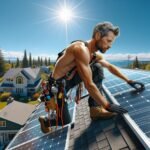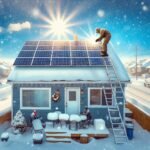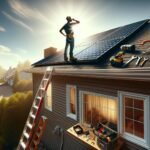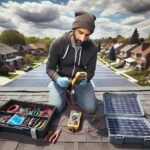Harnessing the power of the sun in Canada might seem like a challenging job, especially with the country’s harsh winters and unpredictable weather. Yet, advancements in solar technology are making it increasingly viable. Did you know that even though snowy conditions, solar panels can still generate electricity efficiently? With the right mounting techniques, you can maximize your solar investment even in less-than-ideal climates.
How can you ensure your solar panels perform optimally throughout the year? By understanding the unique challenges posed by Canadian weather and learning how to properly mount your panels, you can significantly improve their efficiency and lifespan. From selecting the right angle to ensuring snow doesn’t obstruct your panels, there are several strategies to consider.
Ready to unlock the full potential of your solar energy system? Jump into these essential tips for mounting solar panels on Canadian roofs and weatherproofing your investment against the elements.
Understanding Solar Panel Mounting
Mounting solar panels correctly is crucial for optimal performance, especially in Canada’s diverse weather conditions. Let’s jump into key components and different mounting systems that make up efficient solar panel installations.
 diy solar installation: is it really worth it for canadian homeowners?
diy solar installation: is it really worth it for canadian homeowners?Key Components in Solar Panel Mounting
First, consider the essentials. The mounting system is the backbone of any solar array. It includes racks, rails, and clamps that ensure your panels stay secure, even in harsh weather. Have you ever wondered what keeps those panels in place during a heavy snowfall or windy day? Here’s what you need to know:
- Racks: These are the primary support structures. They either attach directly to your roof or stand independently, depending on the system.
- Rails: Mounted on the racks, rails hold the panels. They’re designed to support the weight and alignment.
- Clamps: These secure your panels to the rails. Depending on the type, you’ll find adjustable and fixed options.
- Flashings: These prevent water from seeping through your roof. Proper installation is vital to avoid leaks.
- Bolts and Nuts: High-quality hardware is essential. High-tensile components withstand temperature fluctuations and stress.
By ensuring that each of these components is top-notch and correctly installed, you maximize the lifespan and efficiency of your solar panels. It’s not just about going solar; it’s about ensuring your solar lifestyle is sustainable, even in the face of Canadian winters.
Different Mounting Systems Explained
Not all mounting systems are created equal. Understanding the different types can help you choose what best suits your needs.
- Roof-Mounted Systems: These are popular because they use available roof space. They include both sloped roof systems and flat roof systems. Sloped roof mounts can be flush or tilted, depending on the desired angle for optimal sunlight exposure.
- Ground-Mounted Systems: These are best if you have ample land space. Such systems are easier to install and maintain because they’re accessible without ladders or scaffolding.
- Pole-Mounted Systems: These offer flexibility in angling panels throughout the year. They’re elevated off the ground, reducing the risk of snow accumulation.
But which one is best for you? It depends on factors like roof type, available space, and local weather. For example, ground-mount systems might be more suitable in areas with heavy snowfall, where snow could slide off instead of accumulating on your roof.
Read also: diy solar installation: is it really worth it for canadian homeowners?
diy solar installation: is it really worth it for canadian homeowners? secrets to maximizing solar efficiency in canada’s climate
secrets to maximizing solar efficiency in canada’s climateChoosing the right mounting system is vital to maximizing the benefits of solar panels and ensuring your investment is protected. By understanding these basics, you’re better prepared to make an well-informed choice, guiding you toward a more efficient solar lifestyle. If you’re looking for expert advice, consider exploring the different options my website, Solar Panels for Life, offers.
Assessing Your Canadian Roof for Solar Panels
Wondering if your Canadian roof is ready for solar panels? Let’s break down the essentials to make sure you’re on the right path.
Roof Types Suitable for Solar Panels
Not all roofs are created equal when it comes to solar panels. Flat roofs, for instance, can be ideal because they allow for adjustable mountings to capture maximum sunlight. Pitched roofs, which are quite common in Canada, come with various angles that can either enhance or inhibit solar efficiency depending on their orientation and tilt. Metal roofs are a fantastic option too—they’re durable and often easier to retrofit with solar panels. But what about other materials, like shingles or tiles? They can work well if the right mounting hardware is used. Does your roof type make the cut?
Evaluating Roof Condition
Next up, the condition of your roof is crucial. Is it structurally sound and free from major damages or leaks? Solar panels can last upwards of 25 years, so it’s best if your roof is relatively new or recently repaired before installation. Conduct a professional inspection to assess its health. Don’t forget to consider the weight—solar panels add substantial load, and your roof should be able to handle it. Have you had an inspection lately?
Read also: diy solar installation: is it really worth it for canadian homeowners?
diy solar installation: is it really worth it for canadian homeowners? secrets to maximizing solar efficiency in canada’s climate
secrets to maximizing solar efficiency in canada’s climate the ultimate checklist for installing solar panels in canada
the ultimate checklist for installing solar panels in canadaDetermining Sun Exposure
Ah, sun exposure—the lifeline of your solar panels. Ideally, your roof should get plenty of direct sunlight throughout the day. Check if any obstacles like tall trees, neighboring buildings, or even chimney stacks cast shadows that could affect performance. Use solar mapping tools or consult with experts to gauge the optimal placement. Seasonal changes in sunlight also play a role, and it’s something you need to account for in the winter months. Are you ready to harness the sun’s full potential?
Interested in transforming your home with solar panels? At Solar Panels for Life, we’ve got the info you need to get started on your solar lifestyle today.
Preparing for Canadian Weather Conditions
Installing solar panels on your Canadian roof involves dealing with extreme weather conditions. Here’s how you can ensure your solar lifestyle thrives even in harsh environments.
Impact of Snow and Ice
Snow and ice can significantly impact the efficiency of your solar panels. Heavy snowfall can block sunlight, reducing energy generation. But don’t worry, Solar Panels for Life has you covered. Modern panels are designed to shed snow effectively. Did you know that a slight tilt can help snow slide off more easily? Proper angle and orientation are key. Plus, some systems include heated mounts, preventing ice buildup. Have you ever wondered if maintenance is too high? It’s not. Periodic cleaning and inspections are simple yet effective strategies to maintain peak performance. Embrace winter without compromising your solar energy goals.
Read also: diy solar installation: is it really worth it for canadian homeowners?
diy solar installation: is it really worth it for canadian homeowners? secrets to maximizing solar efficiency in canada’s climate
secrets to maximizing solar efficiency in canada’s climate the ultimate checklist for installing solar panels in canada
the ultimate checklist for installing solar panels in canada 5 tools every canadian needs for a successful solar panel diy
5 tools every canadian needs for a successful solar panel diyHandling Extreme Cold
Canada’s extreme cold can challenge solar panel performance, but it doesn’t make your investment any less valuable. In fact, solar panels operate efficiently in cold weather. Cold increases conductivity, allowing your panels to produce more electricity. What’s the catch? The need for durable materials. Ensure your system includes components that withstand freezing temperatures, like high-quality flashings and seals. Isn’t it fascinating how enduring materials make a difference? Panels from Solar Panels for Life are built to last through frosty winters, minimizing wear and maximizing output.
Managing Wind and Rain
High winds and heavy rain can also pose risks to solar panel installations. Wind can create uplift, potentially damaging poorly mounted panels. It’s crucial to use robust mounting systems designed to endure these forces. Think about how secure your roof-mounted panels need to be. Stainless steel hardware and sturdy clamps ensure a strong hold. When considering rain, proper sealing is essential to prevent water ingress that can lead to corrosion. Ever felt anxious about leaks? Don’t be—with the right setup, your panels stay protected. Reliable installation means you can focus on enjoying your solar lifestyle, rain or shine.
For more expert advice, check out our range of products at Solar Panels for Life and make the most of your solar investment, no matter the weather.
Installation Tips for Canadian Roofs
When installing solar panels in Canada, it’s crucial to consider the unique challenges posed by the country’s variable weather and roof types. Let’s jump into the specifics to ensure your solar installation is efficient and resilient.
Best Practices for Sloped Roofs
Mounting solar panels on sloped roofs presents its own set of challenges and advantages. Success starts with choosing the right mounting system that complements the roof’s angle. Did you know that snow can actually help clean your panels as it slides off?
Ensure panels are installed at an angle that maximizes sun exposure while enabling snow to slide off easily. This prevents the build-up that can block sunlight. Use high-quality roof flashings and sealants to prevent leaks and protect against water damage. A robust framework that includes racks, rails, and clamps ensures your panels withstand harsh Canadian winters.
Also, consider using micro-inverters instead of string inverters. Micro-inverters improve efficiency on sloped roofs by optimizing individual panels, which is crucial if parts of your roof may see shade throughout the day. Finally, always check for local regulations and incentives that might affect your installation. These details are essential to make the most out of your solar lifestyle.
Tips for Flat Roofs
Installing solar panels on flat roofs offers unique advantages and challenges. Flat roofs allow for adjustable mounts, which you can tilt to an optimal angle for sun exposure. What’s more, this flexibility helps prevent snow accumulation and aids in water drainage.
But, wind can be a significant factor. Use ballasted mounting systems to add weight and secure panels against strong gusts. Ballasted systems avoid penetrating the roof, which keeps structural integrity intact and avoids leaks. But, how do you decide the right ballast? It depends on local wind speeds and roof conditions. Always consult with experts to get the balance right.
Another consideration is roof space. Flat roofs often offer more usable area than sloped roofs, allowing for larger installations. Take advantage of this by planning your panel layout to maximize energy generation. Remember, installing walkways between rows of panels ensures access for maintenance and snow removal. This reduces the risk of damage and helps maintain the efficiency of your solar panels.
Securing Panels Against Weather Elements
Canadian weather can be unpredictable and severe, making it crucial to secure your solar panels properly. Start with high-quality mounting hardware that includes corrosion-resistant materials. Rust can compromise the integrity of your system, leading to costly repairs or replacements.
Use edge guards and wind deflectors to protect your panels from high winds. These additions not only shield the panels but also prevent dirt and debris from accumulating. Ever wondered how your panels will cope with heavy rain? Proper sealing techniques are essential to keep your roof intact and your panels operational in wet conditions.
Finally, consider snow guards to prevent large amounts of snow from sliding off suddenly, which could damage objects or hurt people below. Using anti-reflective glass on your panels can also minimize ice formation and help with snow shedding. By focusing on these weather-protective measures, you ensure that your system holds up against Canada’s harsh elements, allowing you to reap the maximum benefits from your investment.
At Solar Panels for Life, we’re committed to helping you make informed decisions for a sustainable future. Discover more tips and products on our website to enhance your solar lifestyle.
Maintenance and Longevity
Maintaining your solar panels effectively ensures longevity and optimal performance, especially in Canada. Given the unique weather challenges, you might wonder how to keep those panels running smoothly year-round.
Regular Maintenance Schedule
Keeping a regular maintenance schedule is crucial. Think of it like maintaining your car; regular checkups prevent bigger issues. You should aim to inspect your panels at least twice a year. Look for dirt, debris, and any potential damage.
We recommend a spring and fall inspection. Spring cleaning removes grime accumulated over winter, while a fall check ensures everything’s ready for the harsher months. Modern panels have self-cleaning coatings, but sometimes a manual wash can boost efficiency.
Don’t forget to check the mounting systems and electrical components. Loose racks, rails, or wiring can impact performance. Use proper cleaning tools, like a soft brush or a garden hose, to avoid scratching the panels. A few hours annually can save you headaches and preserve your solar lifestyle for years to come.
Protecting Panels from Canadian Winters
Canadian winters can be unforgiving. Snow and ice accumulation on your solar panels can limit their effectiveness if not managed correctly. But don’t worry; there are practical ways to protect them.
Firstly, invest in high-quality panels designed for cold climates. These panels shed snow more effectively than standard ones. Secondly, consider the angle of your panels. Steeper angles are better for snow to slide off, ensuring fewer blockages.
Snow guards can also be a good investment. These devices prevent large chunks of snow from slipping off suddenly, which can cause damage. Did you know some panels have heating elements that help melt snow? It’s a worthwhile feature for those particularly harsh winters.
Regularly brushing off snow with a telescopic soft-bristled broom can keep panels clear without climbing up the roof. These simple practices ensure your Solar Panels for Life continue generating energy efficiently, even in the depths of winter.
Ensuring System Longevity
You’ve invested in solar panels, so let’s make them last. Proactive measures guarantee you get the most out of your system. Start by using durable, weather-resistant materials for mounting systems; think stainless steel or anodized aluminum. These materials resist corrosion, a key concern in wet or snowy climates.
Engage professional services for annual inspections and servicing. While DIY checks are helpful, experts can spot issues you might miss. Regular software updates, if your system includes smart inverters, keep everything running efficiently.
How about ensuring protection against high winds? Secure mounts with high-quality bolts and nuts. Heavy-duty flashings can prevent leaks, protecting both panels and the roof.
Finally, consider warranties and insurance for added peace of mind. Most high-quality panels come with warranties of 20-25 years. This long-term security complements your ongoing maintenance efforts, driving the value of your solar lifestyle.
Explore more about maintaining and maximizing your solar investments on Solar Panels for Life, ensuring your panels thrive year-round.
Conclusion
Exploring the complexities of solar panel installation in Canada requires a keen understanding of both the environment and the available technology. By focusing on proper mounting techniques and snow management, you can ensure your solar panels perform efficiently even in harsh weather conditions. Assessing your roof’s suitability, choosing the right mounting system, and adhering to local regulations are crucial steps for a successful installation.
Regular maintenance and the use of durable materials will extend your system’s lifespan and maximize your investment. For more detailed guidance and tips on maintaining your solar panels, visit Solar Panels for Life. With the right approach, your solar investment can thrive no matter the weather.
